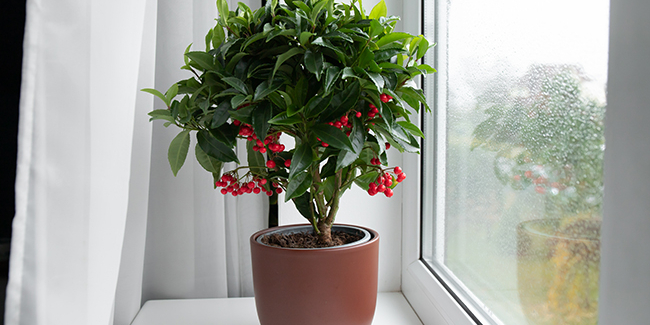The crenellated ardisia (Ardisia crenata syn. Ardisia twitched), also called serrated ardisia, Australian holly or coral berry is an erect shrub native to forest undergrowth in tropical and subtropical regions of East and Southeast Asia. Ardisia fears the cold: -5°C causes it to lose its leaves and -10°C condemns it definitively, which explains why it is grown as an indoor plant in our latitudes.

Its very straight stem with brown bark bears few ramifications but rather a crown of evergreen, leathery, dark green, shiny, alternate, lanceolate (up to 15cm long) and crenate leaves.
In summer, small pink or white, starry and fragrant flowers, gathered in hanging clusters, develop before turning into scarlet red drupes turning black when ripe, about 7mm in diameter. These fruits delight the birds that feed on them in the wild, and contribute to its dispersal since the seed contained in the drupe is rejected by the droppings. Indoors, in the absence of hummingbirds, butterflies and other natural pollinators, only human intervention with a brush to pollinate will produce fruit. And it’s worth it since these pretty clusters of red fruits stay in place for a very long time and make all the decorative interest of the crenellated ardisie. Attention, the drupes of the crenellated ardisia are not edible.
Crenellated ardisia is invasive in certain countries or regions such as Reunion.
- Family: Primulaceae (Myrsinaceae)
- Type: evergreen shrub / houseplant
- Origin: East Asia
- Color: white or pink flowers
- Sowing: yes
- Cutting: yes
- Planting: spring
- Flowering: June to September
- Height: 0.60 to 1.5 m (0.40 to 0.50 m spread)
Ideal soil and exposure for crenellated ardisia
The crenellated ardisia is grown in partial shade, i.e. rather in an eastern exposure, indoors, in a substrate composed of potting soil, heather earth and sand which will facilitate drainage. Better to avoid drafts and offer it around 15°C in winter and 20°C in summer, with good humidity.
Date of sowing, cutting and planting of crenate ardisia
It is in the spring that you will sow the seeds of ardisia, in a greenhouse, at 13-15°C, after having soaked the seeds for 24 hours.
Cuttings of semi-woody stems in summer can be undertaken, smothered, warm.
Repotting is planned in the spring, every 2 or 3 years, because the plant grows slowly.
Council of maintenance and culture of Ardisia
Regular watering, with non-calcareous water, in spring and summer should help keep the substrate cool, then in winter, it will be a little more spaced out. Drenching is beneficial but should be stopped during flowering.
Offering the plant a slightly less warm environment in winter (15-18°C) allows it to develop flowering in late spring.
If theArdisia crenata is grown outdoors, it needs a situation sheltered from cold winds to protect it from the cold, in addition to a good mulch at the foot.
Pruning is limited to rebalancing the silhouette of Ardisia crenata, in spring, around April.
Diseases, pests and parasites of crenate ardisia
Mealybug attacks can occur if the atmosphere is too dry.

Location and favorable association of Ardisia crenata
The place of the indoor plant is rather in a room whose window is exposed to the east, or even to the west.
Recommended species and varieties of Ardisia for planting in the garden
Genre Ardisia counts around 250 species but the classifications can vary and therefore change this number. Ardisia crenata is the most commonly encountered species with its cultivars ‘Alba’ with flowers and white drupes, ‘Variegata’ with leaves edged with cream.
Ardisia japonica (50cm) forms a stoloniferous ground cover with evergreen foliage and red berries.
